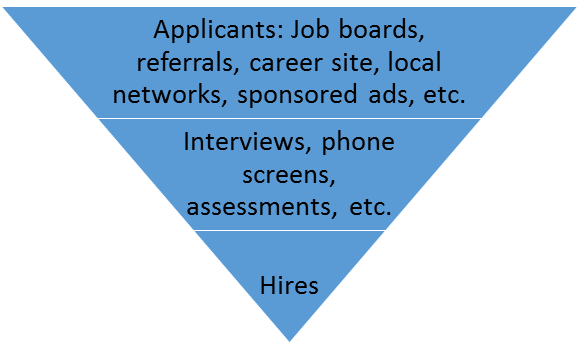 What if you had a way to not only see what sources your candidates were coming from, but which ones delivered you the best people that you ended up hiring? This isn’t just possible–it should be a regular activity you perform as an HR/recruiting leader so that you can validate your hiring efforts and expenditures. For instance, what if that job ad you post with every opening sends you a lot of traffic, but nobody actually applies? Or what if your job ads net you a lot of low quality applicants but never anyone that you actually hire?
What if you had a way to not only see what sources your candidates were coming from, but which ones delivered you the best people that you ended up hiring? This isn’t just possible–it should be a regular activity you perform as an HR/recruiting leader so that you can validate your hiring efforts and expenditures. For instance, what if that job ad you post with every opening sends you a lot of traffic, but nobody actually applies? Or what if your job ads net you a lot of low quality applicants but never anyone that you actually hire?
According to the Modern Measures of Success in Talent Acquisition study, just 30% of companies are regularly tracking metrics around source of hire, and a quarter of companies aren’t tracking it at all. As I pointed out in a previous post on measurement and KPI’s, companies have a variety of priorities and are focused mainly on talent attraction and engagement.
Recently I was talking with a client about their recruiting practices. While they have things like salary negotiation and first year retention down as far as recruiting goes, they are having some challenges on the technology side. They currently spend a healthy chunk of money every month sponsoring job ads to reach candidates. I am working with them to build a business case for implementing a new applicant tracking system to allow candidates to apply via a mobile-friendly careers page, feed jobs to various job boards, and create a collaborative hiring environment between managers and recruiters. Their current methods are not allowing them to generate applicant flow logs and other reports that they need for EEO/OFCCP compliance, and the new system will solve that problem.
The challenge comes with their limited budget. If they are spending the money on a recruiting system, then there is less to spend on the sponsored job posts. The problem immediately arose that there were fewer candidates flowing into the system than were found previously with the sponsored advertisements. Hiring managers were a bit unsettled, and the HR team felt like it had to continue spending on ads even though they were also committed to paying for a new applicant tracking system.
My recommendation to them? Look at your source of hire data to see where your best candidates are coming from.
Analyzing Source of Hire
The process for determining source of hire is not challenging if you’re not hiring many people. If you are hiring a lot of people on a regular basis, then hopefully you have a system in place to at least track where they are coming from.
Here is the simple process for determining source of hire.
- Create a spreadsheet
- Put in the names and jobs for your last 20-50 hires, depending on how often you hire new staff
- Add a column to track the source of the candidates (employee referral, sponsored ads, career site, job board, etc.)
Once you have this data, it’s time to do a bit of analysis. Where are you finding your best candidates most often? What source is driving the most hires?
Validating Your Approach
At this point you should be able to see where I’m going with this. By looking at where the candidates are coming from before they ultimately become hires, you are ensuring that your spending is in line with your results.

This ensures you aren’t spending money on resources and advertising channels that aren’t actually performing. Consider this example of a marketing professional trying to gain exposure for her business. She puts $2000 into radio advertising, $2000 into online ads, and $2000 into TV ads.
- The TV ads bring her 100 leads and 10 of them become customers.
- The online ads bring her 1000 leads and 90 of them become customers.
- The radio ads bring her 50 leads and 2 become customers.
Which source was the most effective? If we look purely at conversion rates, the TV ads converted 10% and the other two channels were lower. However, the online ads brought a higher volume and still had a pretty good conversion rate. The radio option was the weakest performing in terms of quantity and quality. Going forward, the marketing pro would use a mix of online and TV ads to continue bringing customers to her business. We can also use the dollars spent to show an ROI. On average, the TV ad customers cost $200 to acquire. That’s valuable information to have, because it tells you how much you have to make on a customer to achieve a breakeven point and start making a profit.
The same concept applies for recruiting. Let’s say you have spent $1000 on sponsored job ads, $1000 on job board posts, and $1000 on your employee referral program. In this example:
- The sponsored job ads brought you 500 candidates and 10 of them were hired.
- The job board posts brought you 600 candidates and 5 of them were hired.
- The employee referral program brought you 10 candidates and 7 of them were hired.
So, what should you continue spending money on, and what should you scale back? Let’s break it down.
- Sponsored ad conversion rate: 2%
- Job board conversion rate: 0.83%
- Employee referral conversion rate: 70%
Clearly the employee referrals were the winner, but as with life, this isn’t a clear cut answer. While it might make sense to spend more money on employee referrals to drive more leads, it also is a somewhat finite resource, which makes it important to evaluate other sources and continuously try to see what is bringing you the best return. Maybe you tweak your job ads with some split testing and find out that you’re able to triple your conversion rate by linking to some employee testimonials or your salary/hiring data on employee review sites, improving the overall candidate experience.
One final reminder: this might not be the same for all of your jobs or job classes. You may find that for technical/engineering jobs, the best source is a third party recruiter or LinkedIn sponsored content. You may see that admin roles are best filled by job board postings or referrals. That’s why in the first step I had you break down the last set of jobs filled because it’s a good chance that there is a cross section there representative of your organization’s overall hiring efforts.
Once you have your top sources of hire identified, you can move on to things like the candidate experience and recruiting like a marketer to improve your overall results. I recommend a regularly scheduled analysis of your recruiting performance from a source of hire perspective as a way to determine the best sources for finding the right candidates for your organization.
A caveat worth mentioning is this typically only shows you the last touchpoint for a candidate. For instance, if a candidate clicked through an ad, looked at your profile on an employer review site, visited a job board, and then applied on your career page, then all of those steps would not be tracked. However, there are some systems with the horsepower to track the complex candidate journey, such as the suite of tools available from Symphony Talent.
If you’re interested in additional insights on measuring talent acquisition success, be sure to sign up here to get a copy of the upcoming report.
What sources consistently bring you the best candidates and hires? How do you know?

Ben Eubanks is the Chief Research Officer at Lighthouse Research & Advisory. He is an author, speaker, and researcher with a passion for telling stories and making complex topics easy to understand.
His latest book Talent Scarcity answers the question every business leader has asked in recent years: “Where are all the people, and how do we get them back to work?” It shares practical and strategic recruiting and retention ideas and case studies for every employer.
His first book, Artificial Intelligence for HR, is the world’s most-cited resource on AI applications for hiring, development, and employee experience.
Ben has more than 10 years of experience both as an HR/recruiting executive as well as a researcher on workplace topics. His work is practical, relevant, and valued by practitioners from F100 firms to SMB organizations across the globe.
He has spoken to tens of thousands of HR professionals across the globe and enjoys sharing about technology, talent practices, and more. His speaking credits include the SHRM Annual Conference, Seminarium International, PeopleMatters Dubai and India, and over 100 other notable events.

